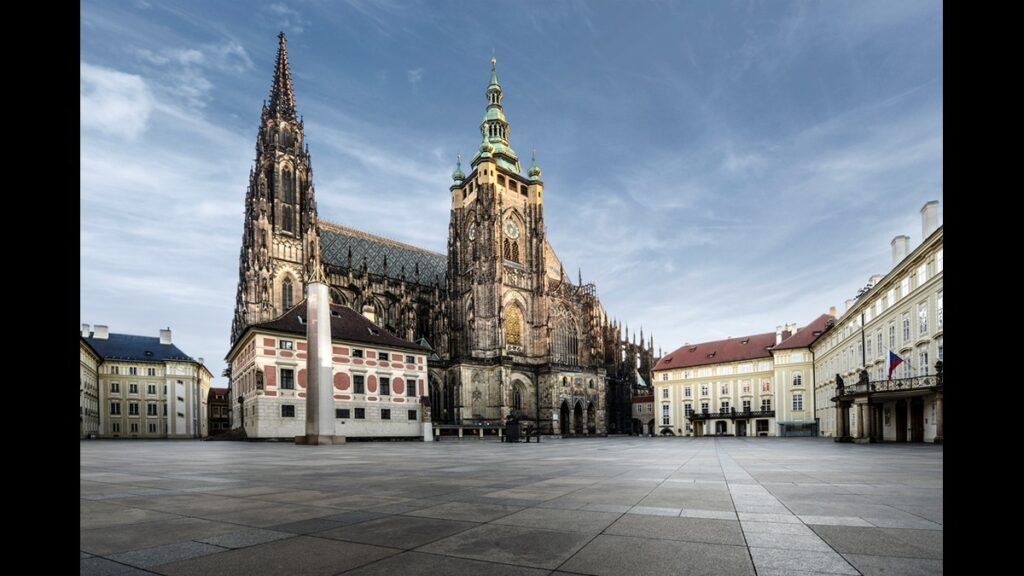5. How to Capture Stunning Photos of 聖ヴィート教会(kostelsv。vita). Vitus Church
Table of Contents
The world is full of breathtaking architectural wonders, each telling a unique story of the time and culture they represent. One such marvel that has captivated visitors from all over the globe is 聖ヴィート教会(kostelsv。vita). Although lesser-known than some iconic European churches, this stunning piece of architecture is an unmissable stop for history buffs, architecture lovers, and those seeking a deeper cultural experience.
In this comprehensive guide, we will explore the rich history, architectural beauty, and cultural significance of 聖ヴィート教会 (Kostel Sv. Vita). Whether you’re 聖ヴィート教会(kostelsv。vita) planning a trip or simply curious to learn more about this hidden gem, you’ll gain an understanding 聖ヴィート教会(kostelsv。vita) of why this church is an essential destination.
The Historical Roots of 聖ヴィート教会(kostelsv。vita)
- The Origins and Significance of St. Vitus
The name Kostel Sv. Vita is dedicated to St. Vitus, a Christian saint who was martyred in the early 4th century. St. Vitus is known as the patron saint of dancers, actors, and 聖ヴィート教会(kostelsv。vita) entertainers, and his feast day is celebrated on June 15. The legacy of St. Vitus became so influential that he was chosen as the patron saint of several churches and cathedrals across Europe, including the famous St. Vitus Cathedral in Prague.
聖ヴィート教会 (Kostel Sv. Vita) was built in 聖ヴィート教会(kostelsv。vita) honor of this saint, with its origins dating back to medieval times. Initially, it served as a modest place of worship for local communities but later evolved into a grand symbol of faith, devotion, and architectural brilliance.
- Historical Events That Shaped the Church
Over the centuries, 聖ヴィート教会 (Kostel Sv. Vita) has 聖ヴィート教会(kostelsv。vita) witnessed significant historical events that have left their mark on the structure and its surroundings. From the early Christianization of the region to the tumultuous wars that swept across Europe, the church has stood as a beacon of resilience.
During the Middle Ages, the church served as a place of refuge and solace for residents during periods of conflict. It also played an important role in the spiritual life of the community, offering not only religious services but also a space for cultural gatherings and social events. Today, 聖ヴィート教会 (Kostel Sv. Vita) stands as a testament to the endurance of faith and tradition, having survived centuries of political and social upheaval.
Architectural Masterpiece: The Design and Construction of 聖ヴィート教会 (Kostel Sv. Vita)
- A Fusion of Styles
One of the most striking features of 聖ヴィート教会 (Kostel Sv. Vita) is its architectural style. Unlike many churches that adhere strictly to one design philosophy, this church boasts a harmonious blend of Gothic, Baroque, and Renaissance elements. The combination 聖ヴィート教会(kostelsv。vita) of these styles makes the church an architectural masterpiece and an intriguing study for historians and architects alike.
- Gothic Influence
The Gothic influence is particularly visible in the tall spires, pointed arches, and intricate detailing that adorn the church’s facade. This style, which originated in the 12th century, is characterized by its verticality and grandeur, both of which are evident in 聖ヴィート教会 (Kostel Sv. Vita). The high ceilings and narrow windows also reflect this Gothic influence, creating 聖ヴィート教会(kostelsv。vita) a sense of awe and reverence for visitors.
- Baroque Elegance
In contrast to the starkness of the Gothic elements, the church also incorporates the opulent flourishes of Baroque architecture, a style known for its dramatic use of color, light, and ornamentation. Inside the church, visitors can find lavish frescoes, gilded altars, and decorative 聖ヴィート教会(kostelsv。vita) sculptures that give the space a sense of warmth and richness. The Baroque period emphasized the theatrical and emotional aspects of religious art, and these features are prominent in the interior design of 聖ヴィート教会 (Kostel Sv. Vita).
- Renaissance Simplicity
The Renaissance influence brings a sense of balance 聖ヴィート教会(kostelsv。vita) and proportion to the church’s design. Renaissance architecture focused on symmetry, clarity, and the revival of classical antiquity, and this is reflected in certain areas of the church, particularly in its structural layout and geometric designs. These Renaissance elements ensure that while the church is ornate, it remains visually balanced and architecturally cohesive.
- Construction and Renovations
Like many historical buildings, 聖ヴィート教会 (Kostel Sv. Vita) 聖ヴィート教会(kostelsv。vita) has undergone several renovations over the centuries. Originally built in the medieval period, the church has been expanded, renovated, and restored at various points in its history. Each renovation brought new elements to the design, contributing to the fusion of architectural styles that we see today.
One significant renovation took place during the Baroque era when artists and architects were commissioned to enhance the church’s interior with decorative artwork, statues, and frescoes. This period of embellishment gave the church its richly adorned 聖ヴィート教会(kostelsv。vita) interior, which remains one of its most stunning features.
Recent restorations have focused on preserving the church’s historical integrity while ensuring that it remains a functional space for worship and tourism. Conservation efforts have been made to protect the delicate frescoes and stone carvings from the effects of time and environmental damage.
The Cultural and Spiritual Significance of 聖ヴィート教会 (Kostel Sv. Vita)

- A Place of Worship and Pilgrimage
For centuries, 聖ヴィート教会 (Kostel Sv. Vita) has been an important place of worship for the local community and pilgrims from afar. Its dedication to St. Vitus, a 聖ヴィート教会(kostelsv。vita) beloved saint in the Christian tradition, has drawn pilgrims seeking spiritual solace and divine intercession. The church continues to hold regular services, including special masses on St. Vitus’ feast day, attracting visitors who wish to partake in the religious significance of this sacred space.
- A Hub of Cultural Heritage
Beyond its role as a religious institution, 聖ヴィート教会 (Kostel Sv. Vita) has also played a key role in preserving and promoting the cultural heritage of the region. Over the years, it has hosted concerts, art exhibitions, and cultural festivals that celebrate the rich history and traditions of the local community.
The church is also home to several invaluable pieces of art, including iconic frescoes, religious statues, and ornate altarpieces, which showcase the artistic talent 聖ヴィート教会(kostelsv。vita) and devotion of the craftsmen who created them. These works of art provide insight into the religious and cultural practices of the time, making the church not only a place of worship but also a living museum of history.
聖ヴィート教会 (Kostel Sv. Vita) in Modern Times
- A Tourist Destination
In recent years, 聖ヴィート教会 (Kostel Sv. Vita) has gained popularity as a tourist destination, attracting visitors from all over the world. Its architectural beauty, historical significance, and cultural relevance make it a must-visit for anyone traveling to the region. Whether you are a history enthusiast, an architecture aficionado, or a spiritual seeker, the church offers something for everyone.
Tourists can take guided tours that explore the history and architecture of the church, while also learning about the religious significance of St. Vitus and the role the 聖ヴィート教会(kostelsv。vita) church has played in the community over the centuries. The peaceful ambiance of the church also makes it a wonderful place for quiet reflection and meditation.
- Preservation and Future Challenges
While the church remains a beloved landmark, it also faces challenges in terms of preservation and maintenance. Like many historical structures, 聖ヴィート教会 (Kostel Sv. Vita) requires ongoing conservation efforts to protect its delicate artwork, stonework, and architectural elements from wear and tear.
There are ongoing initiatives aimed at raising funds for the preservation of the church, with both local organizations and international heritage foundations contributing to the cause. These efforts ensure that future generations will be able to experience the beauty and 聖ヴィート教会(kostelsv。vita) spiritual significance of 聖ヴィート教会 (Kostel Sv. Vita).
Conclusion: Why 聖ヴィート教会 (Kostel Sv. Vita) Should Be on Your Travel List
In conclusion, 聖ヴィート教会 (Kostel Sv. Vita) is more than just a church; it is a symbol of history, culture, and faith. Its rich architectural styles, historical significance, and spiritual importance make it a captivating destination for anyone interested in exploring the deeper aspects 聖ヴィート教会(kostelsv。vita) of human history and culture. From its Gothic spires to its Baroque frescoes, this church offers an unparalleled glimpse into the past while remaining a vibrant part of the present.
Whether you’re planning a visit or simply expanding your knowledge of historical landmarks, 聖ヴィート教会 (Kostel Sv. Vita) is a treasure waiting to be discovered. Don’t miss the 聖ヴィート教会(kostelsv。vita) chance to experience the majesty and mystery of this stunning architectural wonder!



